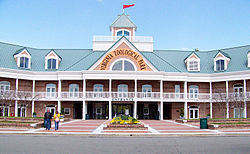Virginia Zoological Park

Main Entrance
|
|
| Date opened | 1900 |
|---|---|
| Location | Norfolk, Virginia, USA |
| Coordinates | 36°52′43″N 76°16′39″W / 36.8786°N 76.2774°WCoordinates: 36°52′43″N 76°16′39″W / 36.8786°N 76.2774°W |
| Land area | 53 acres (21 ha) |
| No. of animals | 350 |
| No. of species | 115 |
| Memberships | AZA |
| Website | www |
The Virginia Zoological Park is a 53-acre (21 ha) zoo located adjacent to Lafayette Park in Norfolk, Virginia, United States. The zoo opened in 1900, and was accredited by the Association of Zoos and Aquariums (AZA) in 1987.
In 1892, the City of Norfolk purchased the 65 acres (26 ha) that was currently occupied by Lafayette Park. In 1900, the park began acquiring animals to exhibit, and by 1901 its collection exceeded 200 animals, including mammals, birds and reptiles.
In 1974, the facility was fenced off from the city park, and renamed Lafayette Zoological Park. Though fenced off, residents of the nearby LaValette Avenue could see the zoo's elephant exhibit from their homes. Newcomers, unfamiliar with the fact that a zoo was in the location, sometimes called the police at the sight of the elephants. Between 1974 and 1980, most of the zoo's old exhibits were renovated.
Also in 1974, the Friends of the Zoo was established to act as a support organization for the development of the zoo. In 1989 it was renamed as the Virginia Zoological Society and established as a non-profit organization.
In 1985, Lafayette Zoological Park was renamed the Virginia Zoological Park at Norfolk (commonly known as the Virginia Zoo). In 1987, the zoo gained accreditation from the Association of Zoos and Aquariums (AZA).
In 1992, a Master Plan was adopted by City of Norfolk and Virginia Zoological Society. Plans included a new Education Complex and Visitor Center, as well as African, North American, Australian, South American and Asian-themed exhibits.
This exhibit was opened in 2011. It features animals from Asia, and nearly doubles the number of large animals at the zoo. Among the animals in this exhibit are Malayan tigers, oriental small-clawed otters, orangutans, siamangs, northern white-cheeked gibbons, Malayan tapirs, binturongs, rhinoceros hornbills, fairy-bluebirds, azure-winged magpies, and chestnut-breasted malkoha. The exhibit includes a raised boardwalk over the "Asian forest", and a cave with views into the tier and orangutan exhibits. Another viewing area allows underwater views of the otters and tigers.
...
Wikipedia
